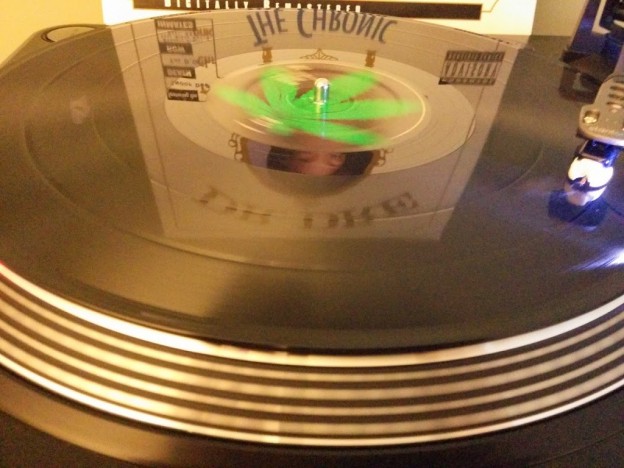I was listening to the owner of a local radio station here in Jackson Mississippi a few weeks ago. We were in a forum setting and people were asking him questions about his station. He owns a Classic Rap station, I asked him to define classic rap, and I was happy with the answer. Basically, the rap I like. Another person asked who his biggest demographic was, his answer surprised me but made complete sense, 30-40 year old white men. And though I believe that he might have been exaggerating I could see his point.
The Album for this week’s Friday Vinyl is none other than Doctor Dre’s The Chronic. Let me say for the record early in high school I would have never admitted to liking this album, in fact by luck I was introduced to this album when I was older and not trying so hard to fit into the heavy metal clique. I was first introduced realistically to this album when I was a junior in High School in 1996. I liked bands like the Beastie Boys and Cypress Hill but for some reason I could argue that they weren’t really rap music. The first time I considered Dr. Dre was during history class when a kid turned around and sold me the “Nuthin But a G Thing” single on cassette for 5 dollars. I bought it because I knew it had been stolen and it made me feel bad ass. Of course it was still a few years before I acknowledged publically that I liked rap music.
Sadly my reasoning had always been racially based. It wasn’t respectable music, not just because of the content but because of the culture behind it, or at least that is what I told myself. Around the same time Metallica was being referred to as Devil Music, Alice Cooper and Ozzy Osborn always had been, and I defended them to the core. For some reason I could say Black Sabbath had been shafted but the themes in Rap music were just inappropriate.
Over the years and through a lot of introspection I learned the real reason I argued so thoroughly that rap music wasn’t real music. First off, the content did make me uncomfortable. They used a lot of sexual language but even more than that they were explaining a culture that was alien to me. I didn’t understand the culture and that misunderstanding led to fear. Living in a predominately white area I didn’t have the chance to interact with many African Americans neither had my family. Of course an easier way to say it is, I was a racist.
I ask your grace on that point because in all honesty, I didn’t understand, but I do now and work to change my perspective and make amends. Everyone around me even the white people were listening to this music, it wasn’t really considered mainstream even for that day, in fact, it was considered disruptive by the mainstream, in hindsight I think that is part of the reason the people around me loved it, and when G Thing came out I could no longer argue I didn’t like the music. I wonder if it is too cheesy to say that Doctor Dre helped me confront my inherent racism.
Of course, that was 1996 and this album came out in 1992. In 92 I was listening to Nirvana, STP, and Pearl Jam. I don’t regret my music choices for the time as much as I regret the limitations I placed upon myself. Over time I learned that all musical genres contain great works, The Chronic is a great work. This album came out in 1992 after the breakup of NWA and Doctor Dre didn’t release another studio album until 2000. I actually owned that album before I owned this one, in fact, this is the first time I bought a full copy. I think part of what I love so much about this album is the difference between this one and Chronic 2001. 1992 introduced us to this young rapper, filled with angst, 2001 gave us that same man, but this time with the ability to look back and see his mistakes. We all know the story, or at least we should, the breakup of NWA, was not very clean and the Doctor and Easy E leapt directly into a feud, a feud that would later fill him with sadness. Easy E died while Dre was in prison, and never getting to say goodbye stayed with him. The road between Death Row and Aftermath was long and hard, but a moral tale for the ages. The first album introduced us to an angry young rapper the second a retrospective father.
In that time Dre introduced us to great artists, and ushered in what some would call the Golden Age of rap, not everyone but some. I don’t know enough about rap music to say whether I agree or not, I know that the 1990’s produced a lot of rap music that I loved in hindsight and the early 2000’s music I loved the first time out.
I haven’t said much about the record itself or the artwork, and they are great but this retrospective isn’t about how wonderful the record is, it is about a visit to the doctor that helped heal my soul.









